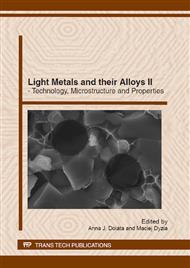p.3
p.13
p.23
p.29
p.37
p.45
p.57
p.67
Numerical and Physical Modelling of Aluminium Refining Process Conducted in URO-200 Reactor
Abstract:
At present both primary and secondary aluminium needs to be refined before further treatment. This can be done by barbotage process, so blowing small bubbles of inert gas into liquid metal. This way harmful impurities especially hydrogen can be removed. Barbotage is very complex taking into consideration hydrodynamics of this process. Therefore modelling research is carried out to get to know the phenomena that take place during the process better. Two different modelling research can be applied: physical and numerical. Physical modelling gives possibility to determine the level of gas dispersion in the liquid metal. Whereas, numerical modelling shows the velocity field distribution, turbulent intensity and volume fraction of gas. The paper presents results of physical and numerical modelling of the refining process taking place in the bath reactor URO-200. Physical modelling was carried out for three different flow rate of refining gas: 5, 10 and 15 dm3/min and three different rotary impeller speeds: 0, 300, 500 rpm Commercial program in Computational Fluid Dynamics was used for numerical calculation. Model VOF (Volume of Fluid) was applied for modelling the multiphase flow. Obtained results were compared in order to verify the numerical settings and correctness of the choice.
Info:
Periodical:
Pages:
3-12
Citation:
Online since:
August 2012
Authors:
Keywords:
Price:
Сopyright:
© 2012 Trans Tech Publications Ltd. All Rights Reserved
Share:
Citation:


